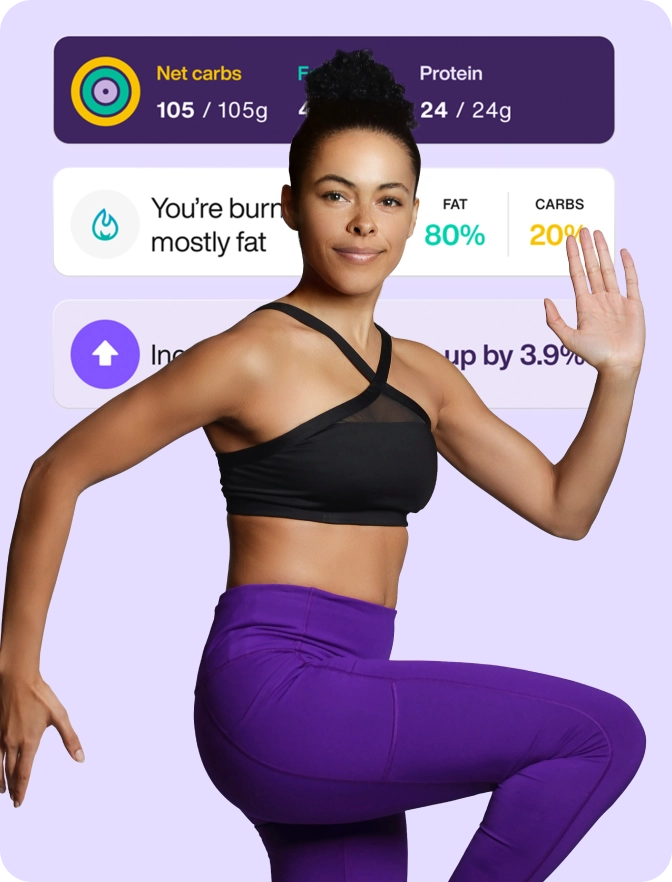Carb cycling vs. keto: Which one is right for you?

From low-carb and keto to Whole 30 and carnivore diets, there are a plethora of nutrition plans to choose from, which can cause decision fatigue and add to the food noise many experience.
People constantly jump from one diet regimen to another and yo-yo diet because many of these approaches can be restrictive and don’t address the root cause of being unable to lose weight or keep it off—the lack of metabolic flexibility.
How easily your mitochondria, the powerhouses of your cells, can shift between using carbs or fats for fuel is known as metabolic flexibility and has several benefits, such as weight management, improved athletic performance, and balanced energy levels.
Improving metabolic flexibility is the foundation for getting the most out of various diet plans, losing weight, and keeping it off long-term. Let’s find out how.

What is carb cycling?
Carb cycling is a dietary approach that alternates between high-carb and low-carb days rather than maintaining constant carbohydrate intake. On high-carb days, eating more carbs increases insulin levels and promotes energy storage and muscle growth. On low-carb days, eating fewer carbs enhances fat burn by lowering insulin and increasing fat utilization for energy.
How exactly does this work?
High-carb days
As the carbs you eat are converted to glucose, the pancreas releases insulin to help move glucose from the bloodstream into your cells, where it can be used for energy. When insulin levels are high, mitochondria are more likely to use carbohydrates for energy1. Insulin also helps open up glucose transporters in muscle cells, and this process of glucose uptake is known as glycogen synthesis2.
Moreover, insulin directly affects muscle protein synthesis, activating the mTOR pathway essential for muscle growth3. This is important because muscles are packed with mitochondria. So, the more muscle mass you gain, the more mitochondria you’ll have to burn fats at rest and shift to carb burn when a quick energy boost is needed.
High-carb days also replenish depleted glycogen, the storage form of carbs in your muscles and liver. Topping up your glycogen is beneficial because it acts as a rapid energy reserve, especially during intense physical exertion. You don’t want your glycogen stores to get too low because your mitochondria won't have the reserves to provide energy boosts, leaving you feeling sluggish.

“Many people believe that adopting a healthy lifestyle means cutting out carbohydrates,” shares Ulrike Kuehl, Head of Nutrition at Lumen. "However, confining ourselves to these carb-restrictive diets for prolonged periods might compromise our metabolic flexibility and prevent us from reaching our health goals.”
Low-carb days
On low-carb days, the focus shifts. Reducing carbohydrate availability makes glycogen stores run low, causing the body to break down its fat stores into energy through a process known as beta-oxidation4.
This move to using fat trains the mitochondria to become more metabolically flexible and efficient at metabolizing fat for energy. During low-carb days, reduced carb intake also helps lower blood sugar levels and decrease insulin secretion.
By manipulating insulin responses and tweaking your metabolism cyclically, your body will be positioned favorably for fat reduction and muscle retention5.
“Nothing else worked for my health or weight until Lumen. I’ve lost 9 lb on Lumen over the past two months and discovered I was eating way too many carbs per day. I was able to get back into running! A huge bonus is that I no longer have sugar cravings.”
Sarah, USA
What’s on the carb cycling menu?
High-carb days feature carbohydrate-rich foods such as:
- Whole grains (e.g., oats, quinoa, and brown rice)
- Fruits and vegetables
- Starchy vegetables (e.g., potatoes and corn)
- Legumes (e.g., beans, lentils, and peas)
Low-carb days focus on the following foods:
- Meat and poultry
- Fish and seafood
- Eggs
- Non-starchy vegetables, such as leafy greens, broccoli, cauliflower, and zucchini
- Healthy fats, such as olive oil, avocado oil, and nuts

What is the keto diet?
The ketogenic diet is a low-carb, high-fat nutrition plan that moves the body into a metabolic state called ketosis, where mitochondria rely on fat for energy. It consists mainly of fats (60-80% of total calories), moderate protein (15-20%), and low carbohydrates (5-10%).
As fat oxidation increases due to low glucose availability, the liver converts fatty acids into ketone bodies to efficiently provide energy. The liver produces three main ketone bodies: beta-hydroxybutyrate, acetoacetate, and acetone.
Ketogenic diets change the body’s metabolic machinery to utilize fats as a primary fuel, which can lead to improved metabolic health6. Evidence also suggests that ketosis leads to weight loss as the body taps into fat stores for energy, helps burn fat, improves insulin resistance, and even sharpens cognitive functions. One study showed that a ketogenic diet may help manage symptoms of metabolic syndrome, a cluster of conditions that increase the risk of heart disease, stroke, and type 2 diabetes7.
The keto diet is not a sustainable nutrition or weight loss solution because long-term keto keeps glycogen levels very low, pushes the body to break down muscles for energy, and causes your mitochondria to rely on fat for fuel. Depleting muscle mass reduces mitochondria and fat-burn potential, while constantly relying on fat for energy can make your mitochondria less efficient at using carbs, leading to reduced metabolic flexibility and quick weight gain when you return to eating carbs. This is why many people follow a cyclical ketosis diet and have carb load days 1-2 times per week.
What’s on the keto menu?
Here are some common foods included in a keto diet:
- Meat and poultry: Beef, chicken, turkey, pork, lamb, bacon, and sausage
- Fish and seafood: Salmon, tuna, sardines, mackerel, shrimp, and shellfish
- Eggs: Whole eggs, omelets, and scrambled eggs
- Healthy fats: Avocado oil, olive oil, coconut oil, butter, ghee, nuts, and seeds
- Low-carb vegetables: Leafy greens, broccoli, cauliflower, zucchini, asparagus, and peppers
- Full-fat dairy: Cheese, cream, and yogurt
“I wanted to try carb cycling and lose just another 10 lb but was afraid I’d gain weight and get out of control again. Then I found Lumen. I’ve been using the program for eight weeks and lost a few more pounds than I would have on keto. Plus, I get recommendations for carbs that allow me to enjoy fruit and pasta without guilt and continue to lose weight.”
Careen, 63, California
How Lumen can help you with carb cycling and cyclical ketosis
Choosing which nutrition plan to follow ultimately comes down to what you can turn into a healthy lifestyle and sustain for the long-term. This can be helped by improving your metabolic flexibility through metabolic trackers like Lumen. By measuring your metabolism, you can determine whether your mitochondria are using fats or carbs for energy, so you know when to cycle in higher-carb days or stick to low-carb days.

Real-time biofeedback
If you measure your wake-up breath and it indicates your mitochondria are primarily burning carbs, you might consider it a low-carb day to encourage your body to tap into its fat stores. If you complete a high-intensity workout and are burning fats after, you might opt to follow a high-carb day to replenish glycogen stores.
Long-term approach
Training your mitochondria to easily switch between carb and fat burn improves your metabolic flexibility, which is the foundation of health and a sustainable way to lose weight and keep it off.
Progress tracking
Consistency is key to reaching your goals. Monitoring your fat-burn and carb-burn states over time can help you stick to your plan and see your progress. A data-driven approach can reveal patterns to refine your dietary strategy if you hit any roadblocks.
Greater flexibility
Instead of relying solely on a fixed meal plan for months on end, carb cycling based on immediate biofeedback is more fluid. It adapts to your metabolism in real time so you can make changes that matter.
People also asked:
1. How do I get started with carb cycling or keto?
Figure out which approach will be the most sustainable for you to follow. Many people might find keto diets to be restrictive if they don’t follow a cyclical plan with carb-loading days. Planning is everything. Be sure to stock up on the foods you’ll need for your high-carb and low-carb days, along with ketogenic options to take out any guesswork.
Whether you follow carb cycling or keto, consult a healthcare provider or nutritionist to tailor the diet to your needs. Research supports personalized dietary planning to reach wellness goals and overall health8.
2. Are there potential side effects to be aware of?
Both diets come with possible side effects. Carb cycling may cause mood swings or energy fluctuations if carb intake is too low or too high, which may cause sudden blood sugar spikes and drops, especially if refined carbs are consumed.
The keto diet can lead to the ”keto flu,” a short-term group of symptoms including headache and fatigue. According to a review article, transitioning into ketosis may also lead to micronutrient deficiencies if not properly managed9.
Build the foundation of metabolic flexibility
Restrictive and one-size-fits-all diets often miss the nuanced needs of an individual, often leading to the cycle of yo-yo dieting and hitting plateaus because nutrition isn’t personalized to metabolism.
By tailoring carb intake to your metabolic rate, activity levels, and health goals, you’re more likely to experience the benefits of metabolic flexibility, sustainable weight loss, better energy levels, and feeling healthier overall.








 Digital download
Digital download 


